Reconstruction of the rRNA Sequences of LUCA, with Bioinformatic Implication of the Local Similarities Shared by Them
Abstract
:Simple Summary
Abstract
1. Introduction
2. Materials and Methods
2.1. Taxon Sampling
2.2. Phylogenetic Analysis
2.3. Reconstruction of Ancestral Sequences of rDNAs
2.4. Searching and Filtering the Short Fragments
2.5. Mapping Short Fragments on Secondary and Tertiary Structures
3. Results
3.1. Phylogenetic Relationships of Archaea and Bacteria
3.2. Ancestral Sequences of 16S, 5S, and 23S rRNAs
3.3. Short Fragments Shared by 16S, 5S, and 23S rRNAs
3.4. Short Fragments Largely Covered the PTC and the Inter-Subunit Interface of Ribosome
3.5. The Conservativeness of Short Fragments
3.6. Functional Attributes of the Short Fragments Checked with the Knowledge of Structural Biology
3.7. Alternative Strategy of AUGC Level
4. Discussion
5. Conclusions
Supplementary Materials
Author Contributions
Funding
Institutional Review Board Statement
Informed Consent Statement
Data Availability Statement
Conflicts of Interest
References
- Gilbert, W. Origin of Life: The RNA World. Nature 1986, 319, 618. [Google Scholar] [CrossRef]
- Yarus, M. Getting Past the RNA World: The Initial Darwinian Ancestor. Cold Spring Harb. Perspect. Biol. 2011, 3, a003590. [Google Scholar] [CrossRef] [PubMed] [Green Version]
- Cech, T.R. The RNA Worlds in Context. Cold Spring Harb. Perspect. Biol. 2012, 4, a006742. [Google Scholar] [CrossRef] [PubMed] [Green Version]
- Kruger, K.; Grabowski, P.J.; Zaug, A.J.; Sands, J.; Gottschling, D.E.; Cech, T.R. Self-splicing RNA: Autoexcision and Autocyclization of the Ribosomal RNA Intervening Sequence of Tetrahymena. Cell 1982, 31, 147–157. [Google Scholar] [CrossRef]
- Guerrier-Takada, C.; Gardiner, K.; Marsh, T.; Pace, N.; Altman, S. The RNA Moiety of Ribonuclease P Is the Catalytic Subunit of the Enzyme. Cell 1983, 35, 849–857. [Google Scholar] [CrossRef]
- Miller, S.L. A Production of Amino Acids Under Possible Primitive Earth Conditions. Science 1953, 117, 528–529. [Google Scholar] [CrossRef] [Green Version]
- Ferus, M.; Pietrucci, F.; Saitta, A.M.; Knizek, A.; Kubelik, P.; Ivanek, O.; Shestivska, V.; Civis, S. Formation of Nucleobases in a Miller-Urey Reducing Atmosphere. Proc. Natl. Acad. Sci. USA 2017, 114, 4306–4311. [Google Scholar] [CrossRef] [Green Version]
- Fox, G.E. Origin and Evolution of the Ribosome. Cold Spring Harb. Perspect. Biol. 2010, 2, a003483. [Google Scholar] [CrossRef] [Green Version]
- Bokov, K.; Steinberg, S.V.A. Hierarchical Model for Evolution of 23S Ribosomal RNA. Nature 2009, 457, 977–980. [Google Scholar] [CrossRef]
- Bowman, J.C.; Petrov, A.S.; Frenkelpinter, M.; Penev, P.I.; Williams, L.D. Root of the Tree: The Significance, Evolution, and Origins of the Ribosome. Chem. Rev. 2020, 120, 4848–4878. [Google Scholar] [CrossRef]
- Yoon, S.H.; Ha, S.M.; Kwon, S.; Lim, J.; Kim, Y.; Seo, H.; Chun, J. Introducing EzBioCloud: A Taxonomically United Database of 16S rRNA and Whole Genome Assemblies. Int. J. Syst. Evol. Microbiol. 2017, 67, 1613–1617. [Google Scholar] [CrossRef] [PubMed]
- Petersen, M.; Meusemann, K.; Donath, A.; Dowling, D.; Liu, S.L.; Peters, R.S.; Podsiadlowski, L.; Vasilikopoulos, A.; Zhou, X.; Misof, B.; et al. Orthograph: A Versatile Tool for Mapping Coding Nucleotide Sequences to Clusters of Orthologous Genes. BMC Bioinf. 2017, 18, 111. [Google Scholar] [CrossRef] [Green Version]
- Zhu, Q.Y.; Mai, U.; Pfeiffer, W.; Janssen, S.; Asnicar, F.; Sanders, J.G.; Belda-Ferre, P.; Al-Ghalith, G.A.; Kopylova, E.; McDonald, D.; et al. Phylogenomics of 10,575 Genomes Reveals Evolutionary Proximity Between Domains Bacteria and Archaea. Nat. Commun. 2019, 10, 5477. [Google Scholar] [CrossRef] [Green Version]
- Katoh, K.; Standley, D.M. MAFFT Multiple Sequence Alignment Software Version 7: Improvements in Performance and Usability. Mol. Biol. Evol. 2013, 30, 772–780. [Google Scholar] [CrossRef] [PubMed] [Green Version]
- Talavera, G.; Castresana, J. Improvement of Phylogenies After Removing Divergent and Ambiguously Aligned Blocks from Protein Sequence Alignments. Syst. Biol. 2007, 56, 564–577. [Google Scholar] [CrossRef] [PubMed] [Green Version]
- Vaidya, G.; Lohman, D.J.; Meier, R. SequenceMatrix: Concatenation Software for the Fast Assembly of Multi-gene Datasets with Character Set and Codon Information. Cladistics 2011, 27, 171–180. [Google Scholar] [CrossRef]
- Nguyen, L.T.; Schmidt, H.A.; von Haeseler, A.; Minh, B.Q. IQ-TREE: A Fast and Effective Stochastic Algorithm for Estimating Maximum-likelihood Phylogenies. Mol. Biol. Evol. 2015, 32, 268–274. [Google Scholar] [CrossRef]
- Stamatakis, A. RAxML Version 8: A Tool for Phylogenetic Analysis and Post-analysis of Large Phylogenies. Bioinformatics 2014, 30, 1312–1313. [Google Scholar] [CrossRef]
- Lemoine, F.; Entfellner, J.B.D.; Wilkinson, E.; Correia, D.; Felipe, M.D.; De Oliveira, T.; Gascuel, O. Renewing Felsenstein’s Phylogenetic Bootstrap in the Era of Big Data. Nature 2018, 556, 452–456. [Google Scholar] [CrossRef]
- Rundlet, E.J.; Holm, M.; Schacherl, M.; Natchiar, S.K.; Altman, R.B.; Spahn, C.M.T.; Myasnikov, A.G.; Blanchard, S.C. Structural Basis of Early Translocation Events on the Ribosome. Nature 2021, 595, 741–745. [Google Scholar] [CrossRef]
- Parks, D.H.; Chuvochina, M.; Chaumeil, P.A.; Rinke, C.; Mussig, A.J.; Hugenholtz, P. A Complete Domain-to-species Taxonomy for Bacteria and Archaea. Nat. Biotechnol. 2020, 38, 1079–1086. [Google Scholar] [CrossRef] [PubMed]
- Rinke, C.; Chuvochina, M.; Mussig, A.J.; Chaumeil, P.A.; Davin, A.A.; Waite, D.W.; Whitman, W.B.; Parks, D.H.; Hugenholtz, P. A Standardized Archaeal Taxonomy for the Genome Taxonomy Database. Nat. Microbiol. 2021, 6, 946–959. [Google Scholar] [CrossRef] [PubMed]
- Eme, L.; Spang, A.; Lombard, J.; Stairs, C.W.; Ettema, T.J.G. Archaea and the Origin of Eukaryotes. Nat. Rev. Microbiol. 2017, 15, 711–723. [Google Scholar] [CrossRef]
- Liu, Y.; Makarova, K.S.; Huang, W.C.; Wolf, Y.I.; Nikolskaya, A.N.; Zhang, X.X.; Cai, M.W.; Zhang, C.J.; Xu, W.; Luo, Z.H.; et al. Expanded Diversity of Asgard Archaea and Their Relationships with Eukaryotes. Nature 2021, 593, 553–557. [Google Scholar] [CrossRef] [PubMed]
- Bashan, A.; Agmon, I.; Zarivach, R.; Schluenzen, F.; Harms, J.; Berisio, R.; Bartels, H.; Franceschi, F.; Auerbach, T.; Hansen, H.A.S.; et al. Structural Basis of the Ribosomal Machinery for Peptide Bond Formation, Translocation, and Nascent Chain Progression. Mol. Cell 2003, 11, 91–102. [Google Scholar] [CrossRef]
- Doring, T.; Mitchell, P.; Osswald, M.; Bochkariov, D.; Brimacombe, R. The Decoding Region of 16S RNA; A Cross-linking Study of the Ribosomal A, P and E Sites Using tRNA Derivatized at Position 32 in the Anticodon Loop. EMBO J. 1994, 13, 2677–2685. [Google Scholar] [CrossRef]
- Green, R.; Noller, H.F. Ribosomes and Translation. Annu. Rev. Biochem. 1997, 66, 679–716. [Google Scholar] [CrossRef]
- Moazed, D.; Noller, H.F. Binding of tRNA to the Ribosomal A and P Sites Protects Two Distinct Sets of Nucleotides in 16S rRNA. J. Mol. Biol. 1990, 211, 135–145. [Google Scholar] [CrossRef]
- Nissen, P.; Ippolito, J.A.; Ban, N.; Moore, P.B.; Steitz, T.A. RNA Tertiary Interactions in the Large Ribosomal Subunit: The A-minor Motif. Proc. Natl. Acad. Sci. USA 2001, 98, 4899–4903. [Google Scholar] [CrossRef] [Green Version]
- Polacek, N.; Mankin, A.S. The Ribosomal Peptidyl Transferase Center: Structure, Function, Evolution, Inhibition. Crit. Rev. Biochem. Mol. Biol. 2005, 40, 285–311. [Google Scholar] [CrossRef]
- Santer, U.V.; Cekleniak, J.; Kansil, S.; Santer, M.; O’Connor, M.; Dahlberg, A.E. A Mutation at the Universally Conserved Position 529 in Escherichia coli 16S rRNA Creates a Functional but Highly Error Prone Ribosome. RNA 1995, 1, 89–94. [Google Scholar] [PubMed]
- Yusupov, M.M.; Yusupova, G.Z.; Baucom, A.; Lieberman, K.; Earnest, T.N.; Cate, J.H.D.; Noller, H.F. Crystal Structure of the Ribosome at 5.5 Resolution. Science 2001, 292, 883–896. [Google Scholar] [CrossRef] [PubMed]
- Zarivach, R.; Bashan, A.; Berisio, R.; Harms, J.; Auerbach, T.; Schluenzen, F.; Bartels, H.; Baram, D.; Pyetan, E.; Sittner, A.; et al. Functional Aspects of Ribosomal Architecture: Symmetry, Chirality and Regulation. Phys. Org. Chem. 2004, 17, 901–991. [Google Scholar] [CrossRef]
- Bhangu, R.; Wollenzien, P. The mRNA Binding Track in the Escherichia coli Ribosome for mRNAs of Different Sequences. Biochemistry 1992, 31, 5937–5944. [Google Scholar] [CrossRef] [PubMed]
- Bhangu, R.; Juzumiene, D.; Wollenzien, P. Arrangement of Messenger RNA on Escherichia coli Ribosomes with Respect to 10 16S rRNA Cross-linking Sites. Biochemistry 1994, 33, 3063–3070. [Google Scholar] [CrossRef] [PubMed]
- Juzumiene, D.I.; Shapkina, T.G.; Wollenzien, P. Distribution of Cross-links between mRNA Analogues and 16S rRNA in Escherichia coli 70S Ribosomes Made Under Equilibrium Conditions and Their Response to tRNA Binding. J. Biol. Chem. 1995, 270, 12794–12800. [Google Scholar] [CrossRef] [PubMed] [Green Version]
- Rinke-Appel, J.; Junke, N.; Brimacombe, R.; Dukudovskaya, S.; Dontsova, O.; Bogdanov, A. Site-directed Cross-linking of mRNA Analogues to 16S Ribosomal RNA; A Complete Scan of Cross-links from All Positions Between ‘+1’ and ‘+16’ on the mRNA, Downstream from the Decoding Site. Nucleic Acids Res. 1993, 21, 2853–2859. [Google Scholar] [CrossRef] [Green Version]
- Ogle, J.M.; Brodersen, D.E.; Clemons, W.M.; Tarry, M.J.; Carter, A.P.; Ramakrishnan, V. Recognition of Cognate Transfer RNA by the 30S Ribosomal Subunit. Science 2001, 29, 897–902. [Google Scholar] [CrossRef] [Green Version]
- Huttenhofer, A.; Noller, H.F. Footprinting mRNA-ribosome Complexes with Chemical Probes. EMBO J. 1994, 13, 3892–3901. [Google Scholar] [CrossRef]
- Stade, K.; Riens, S.; Bochkariov, D.; Brimacombe, R. Contacts between the Growing Peptide Chain and the 23S RNA in the 50S Ribosomal Subunit. Nucleic Acids Res. 1994, 22, 1394–1399. [Google Scholar] [CrossRef]
- Agmon, I.; Amit, M.; Auerbach, T.; Bashan, A.; Baram, D.; Bartels, H.; Berisio, R.; Greenberg, I.; Harms, J.; Hansen, H.A.S.; et al. Ribosomal Crystallography: A Flexible Nucleotide Anchoring tRNA Translocation, Facilitates Peptide-bond Formation, Chirality Discrimination and Antibiotics Synergism. FEBS Lett. 2004, 567, 20–26. [Google Scholar] [CrossRef] [PubMed]
- Bashan, A.; Zarivach, R.; Schluenzen, F.; Agmon, I.; Harms, J.; Auerbach, T.; Baram, D.; Berisio, R.; Bartels, H.; Hansen, H.A.S.; et al. Ribosomal Crystallography: Peptide Bond Formation and Its Inhibition. Biopolymers 2003, 70, 19–41. [Google Scholar] [CrossRef] [PubMed]
- Koch, M.; Willi, J.; Pradere, U.; Hall, J.; Polacek, N. Critical 23S rRNA Interactions for Macrolide-dependent Ribosome Stalling on the ErmCL Nascent Peptide Chain. Nucleic Acids Res. 2017, 45, 6717–6728. [Google Scholar] [CrossRef] [PubMed]
- O’Connor, M.; Goringer, H.U.; Dahlberg, A.E. A Ribosomal Ambiguity Mutation in the 530 Loop of E. coli 16S rRNA. Nucleic Acids Res. 1992, 20, 4221–4227. [Google Scholar] [CrossRef]
- Yonath, A. Antibiotics Targeting Ribosomes: Resistance, Selectivity, Synergism, and Cellular Regulation. Annu. Rev. Biochem. 2005, 74, 649–679. [Google Scholar] [CrossRef] [Green Version]
- Yoshizawa, S.; Fourmy, D.; Puglisi, J.D. Recognition of the Codon-anticodon Helix by Ribosomal RNA. Science 1999, 285, 1722–1725. [Google Scholar] [CrossRef] [Green Version]
- Schmeing, T.M.; Huang, K.S.; Strobel, S.A.; Steitz, T.A. An Induced-fit Mechanism to Promote Peptide Bond Formation and Exclude Hydrolysis of Peptidyl-tRNA. Nature 2005, 438, 520–524. [Google Scholar] [CrossRef]
- Dedkova, L.M.; Hecht, S.M. Expanding the Scope of Protein Synthesis Using Modified Ribosomes. J. Am. Chem. Soc. 2019, 141, 6430–6447. [Google Scholar] [CrossRef]
- Voorhees, R.M.; Weixlbaumer, A.; Loakes, D.; Kelley, A.C.; Ramakrishnan, V. Insights into Substrate Stabilization from Snapshots of the Peptidyl Transferase Center of the Intact 70S Ribosome. Nat. Struct. Mol. Biol. 2009, 16, 528–533. [Google Scholar] [CrossRef] [Green Version]
- Gao, H.X.; Sengupta, J.; Valle, M.; Korostelev, A.; Eswar, N.; Stagg, S.M.; Van Roey, P.; Agrawal, R.K.; Harvey, S.C.; Sali, A.; et al. Study of the Structural Dynamics of the E. coli 70S Ribosome Using Real-space Refinement. Cell 2003, 113, 789–801. [Google Scholar]
- Schmeing, T.M.; Ramakrishnan, V. What Recent Ribosome Structures Have Revealed About the Mechanism of Translation. Nature 2009, 461, 1234–1242. [Google Scholar] [CrossRef] [PubMed]
- Poehlsgaard, J.; Douthwaite, S. The Bacterial Ribosome as a Target for Antibiotics. Nat. Rev. Microbiol. 2005, 3, 870–881. [Google Scholar] [CrossRef] [PubMed]
- Allen, G.S.; Zavialov, A.; Gursky, R.; Ehrenberg, M.; Frank, J. The Cryo-EM Structure of a Translation Initiation Complex from Escherichia coli. Cell 2005, 121, 703–712. [Google Scholar] [CrossRef] [PubMed] [Green Version]
- Klaholz, B.P.; Myasnikov, A.G.; Van Heel, M. Visualization of Release Factor 3 on the Ribosome During Termination of Protein Synthesis. Nature 2004, 427, 862–865. [Google Scholar] [CrossRef]
- Moazed, D.; Robertson, J.M.; Noller, H.F. Interaction of elongation factors EF-G and EF-Tu with a conserved loop in 23S RNA. Nature 1988, 334, 362–364. [Google Scholar] [CrossRef]
- Stark, H.; Stark, H.; Rodnina, M.V.; Wieden, H.J.; Zemlin, F.; Wintermeyer, W.; van Heel, M. Ribosome Interactions of Aminoacyl-tRNA and Elongation Factor Tu in the Codon-recognition Complex. Nat. Struct. Biol. 2002, 9, 849–854. [Google Scholar] [CrossRef]
- Valle, M.; Zavialov, A.; Li, W.; Stagg, S.M.; Sengupta, J.; Nielsen, R.C.; Nissen, P.; Harvey, S.C.; Ehrenberg, M.; Frank, J. Incorporation of Aminoacyl-tRNA into the Ribosome as Seen by Cryo-electron Microscopy. Nat. Struct. Biol. 2003, 10, 899–906. [Google Scholar] [CrossRef]
- Valle, M.; Zavialov, A.; Sengupta, J.; Rawat, U.; Ehrenberg, M.; Frank, J. Locking and Unlocking of Ribosomal Motions. Cell 2003, 114, 123–134. [Google Scholar] [CrossRef] [Green Version]
- Crick, F.H.C. The Origin of the Genetic Code. J. Mol. Biol. 1968, 38, 367–379. [Google Scholar] [CrossRef]
- Hug, L.A.; Baker, B.J.; Anantharaman, K.; Brown, C.T.; Probst, A.J.; Castelle, C.J.; Butterfield, C.N.; Hernsdorf, A.W.; Amano, Y.; Ise, K.; et al. A New View of the Tree of Life. Nat. Microbiol. 2016, 1, 16048. [Google Scholar] [CrossRef] [Green Version]
- Williams, T.A.; Cox, C.J.; Foster, P.G.; Szollosi, G.J.; Embley, T.M. Phylogenomics Provides Robust Support for A Two-domains Tree of Life. Nat. Ecol. Evol. 2020, 4, 138–147. [Google Scholar] [CrossRef] [PubMed]
- Martínez Giménez, J.A.; Sáez, G.T.; Seisdedos, R.T. On the Function of Modified Nucleosides in the RNA World. J. Theor. Biol. 1998, 194, 485–490. [Google Scholar] [CrossRef] [PubMed]
- Davidovich, C.; Belousoff, M.; Wekselman, I.; Shapira, T.; Krupkin, M.; Zimmerman, E.; Bashan, A.; Yonath, A. The Proto-ribosome: An Ancient Nano-machine for Peptide Bond Formation. Isr. J. Chem. 2010, 50, 29–35. [Google Scholar] [CrossRef] [PubMed]
- Huang, L.L.; Krupkin, M.; Bashan, A.; Yonath, A.; Massa, L. Protoribosome by Quantum Kernel Energy Method. Proc. Natl. Acad. Sci. USA 2013, 110, 14900–14905. [Google Scholar] [CrossRef] [PubMed] [Green Version]
- Agmon, I.C. Could a Proto-ribosome Emerge Spontaneously in the Prebiotic World? Molecules 2016, 21, 1701. [Google Scholar] [CrossRef] [Green Version]
- Petrov, A.S.; Bernier, C.R.; Hsiao, C.L.; Norris, A.M.; Kovacs, N.A.; Waterbury, C.C.; Stepanov, V.G.; Harvey, S.C.; Fox, G.E.; Wartell, R.M.; et al. Evolution of the Ribosome at Atomic Resolution. Proc. Natl. Acad. Sci. USA 2014, 111, 10251–10256. [Google Scholar] [CrossRef] [Green Version]
- Petrov, A.S.; Gulen, B.; Norris, A.M.; Kovacs, N.A.; Bernier, C.R.; Lanier, K.A. History of the Ribosome and the Origin of Translation. Proc. Natl. Acad. Sci. USA 2015, 112, 15396–15401. [Google Scholar] [CrossRef] [Green Version]

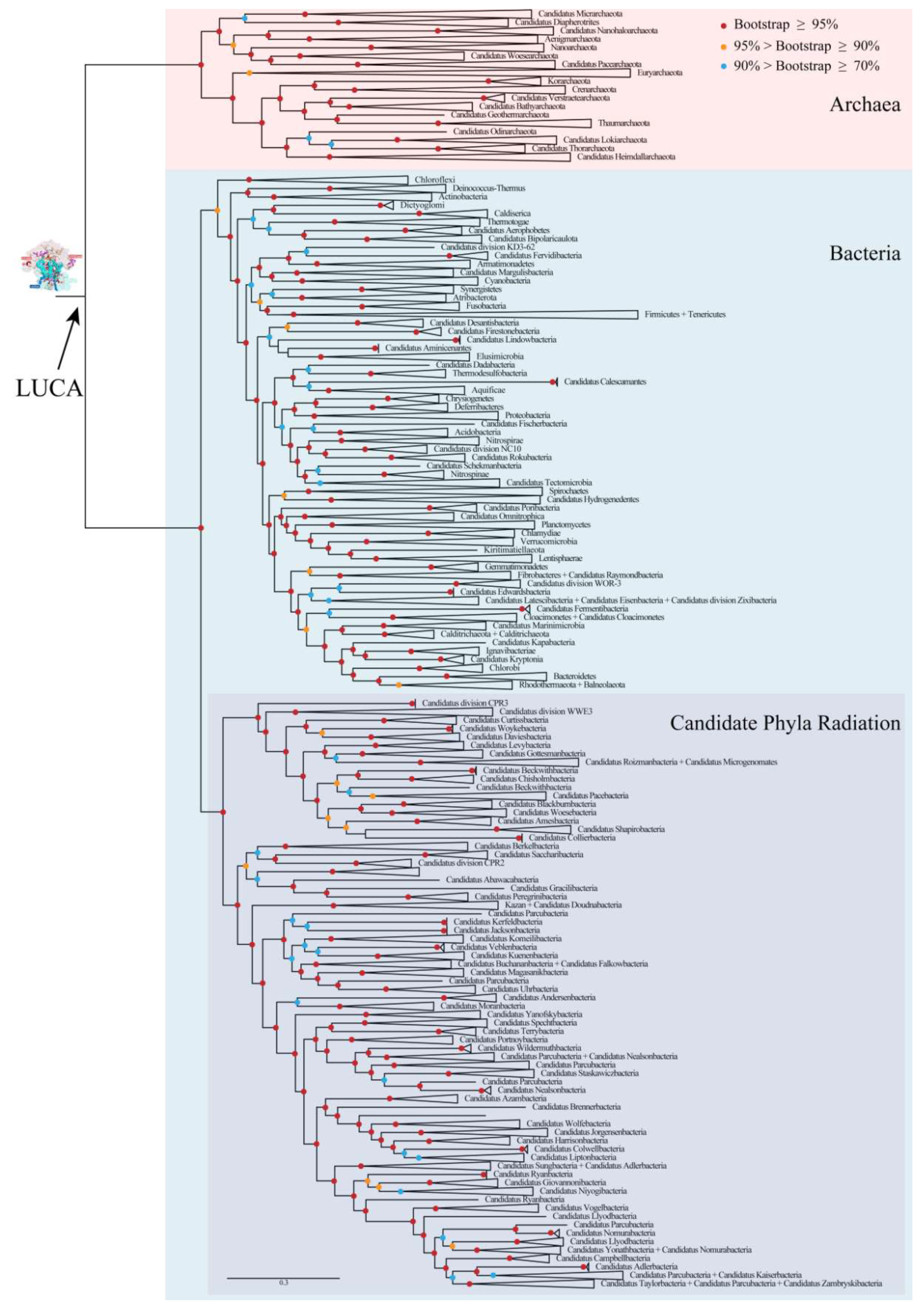
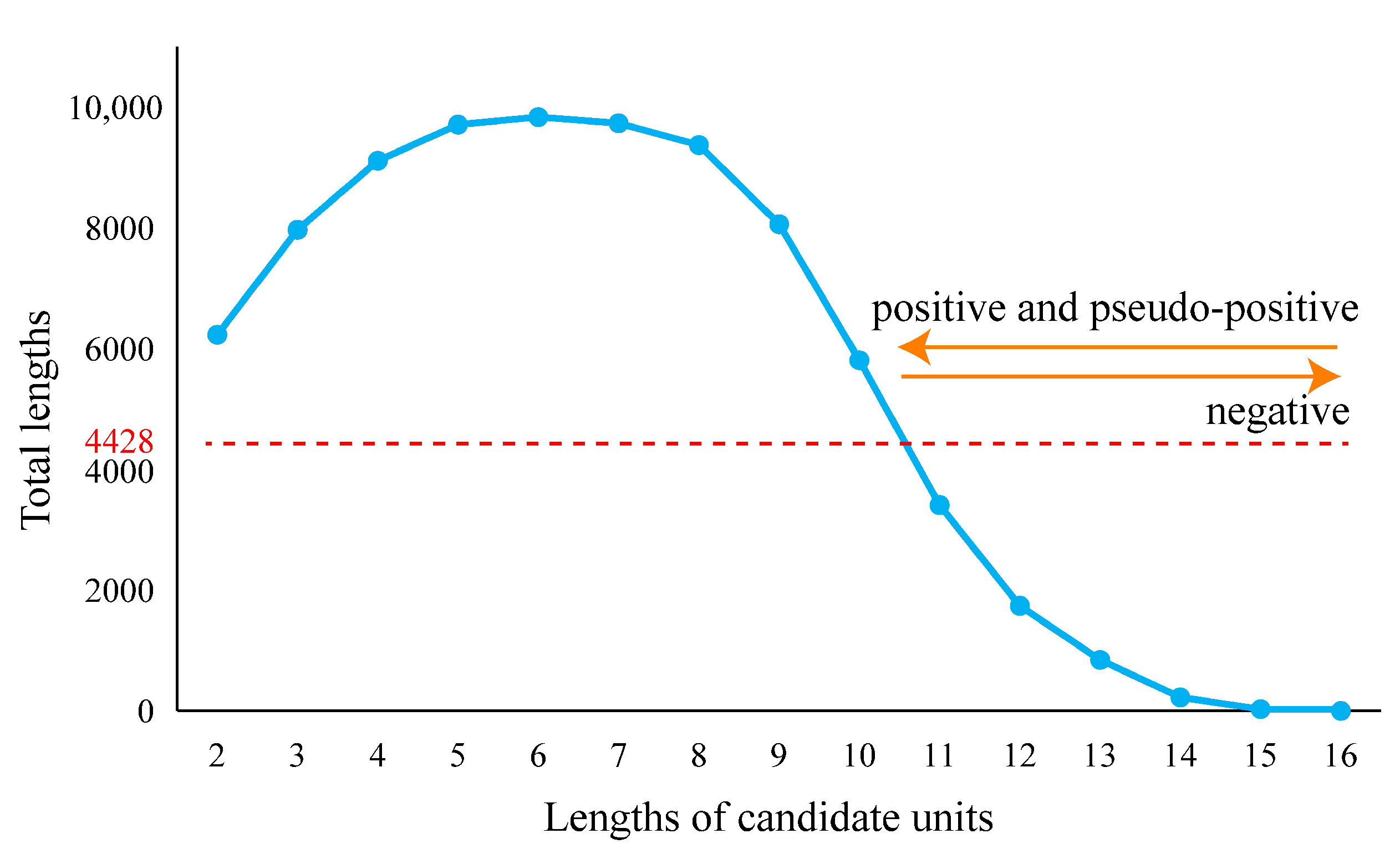
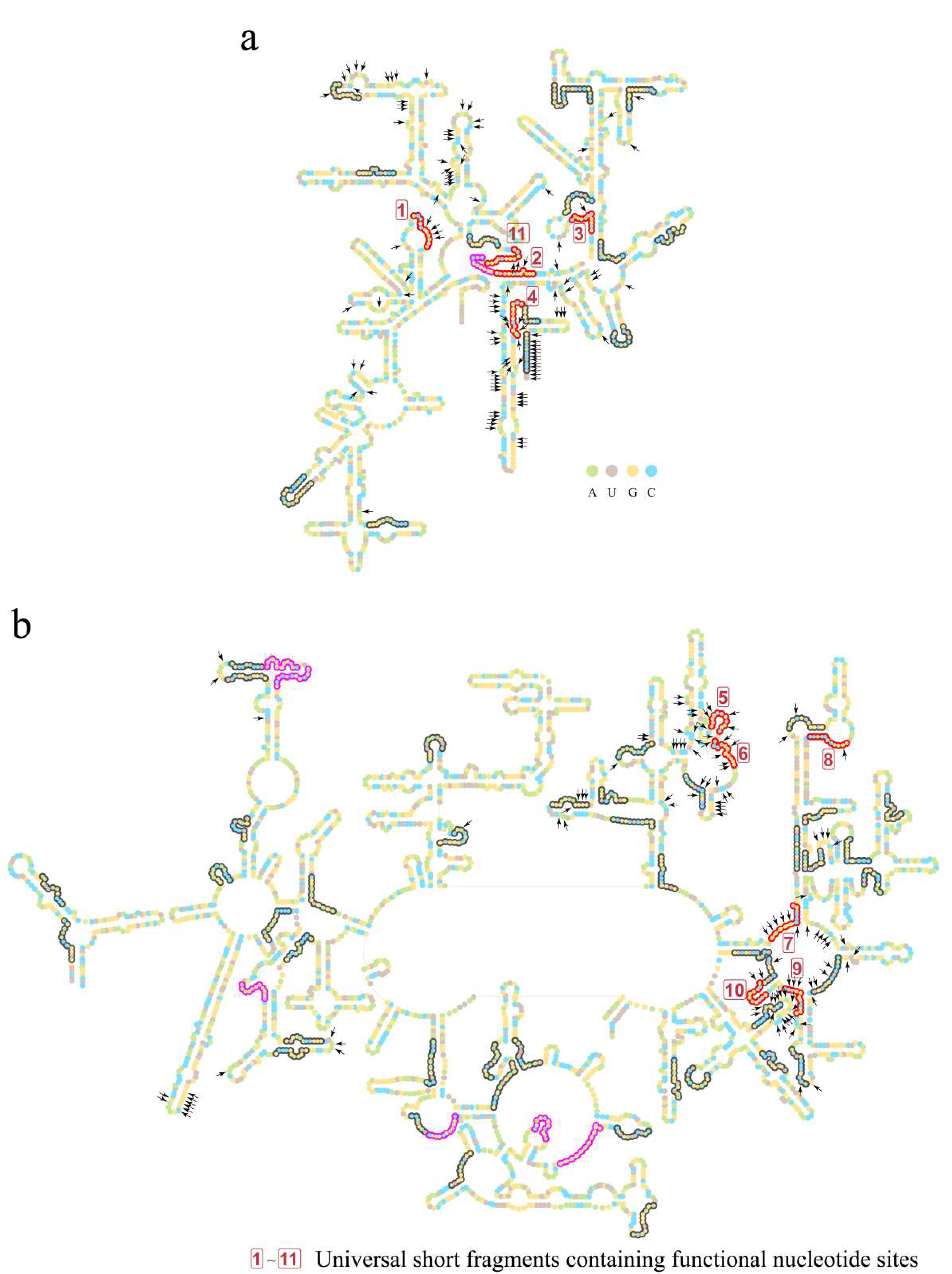
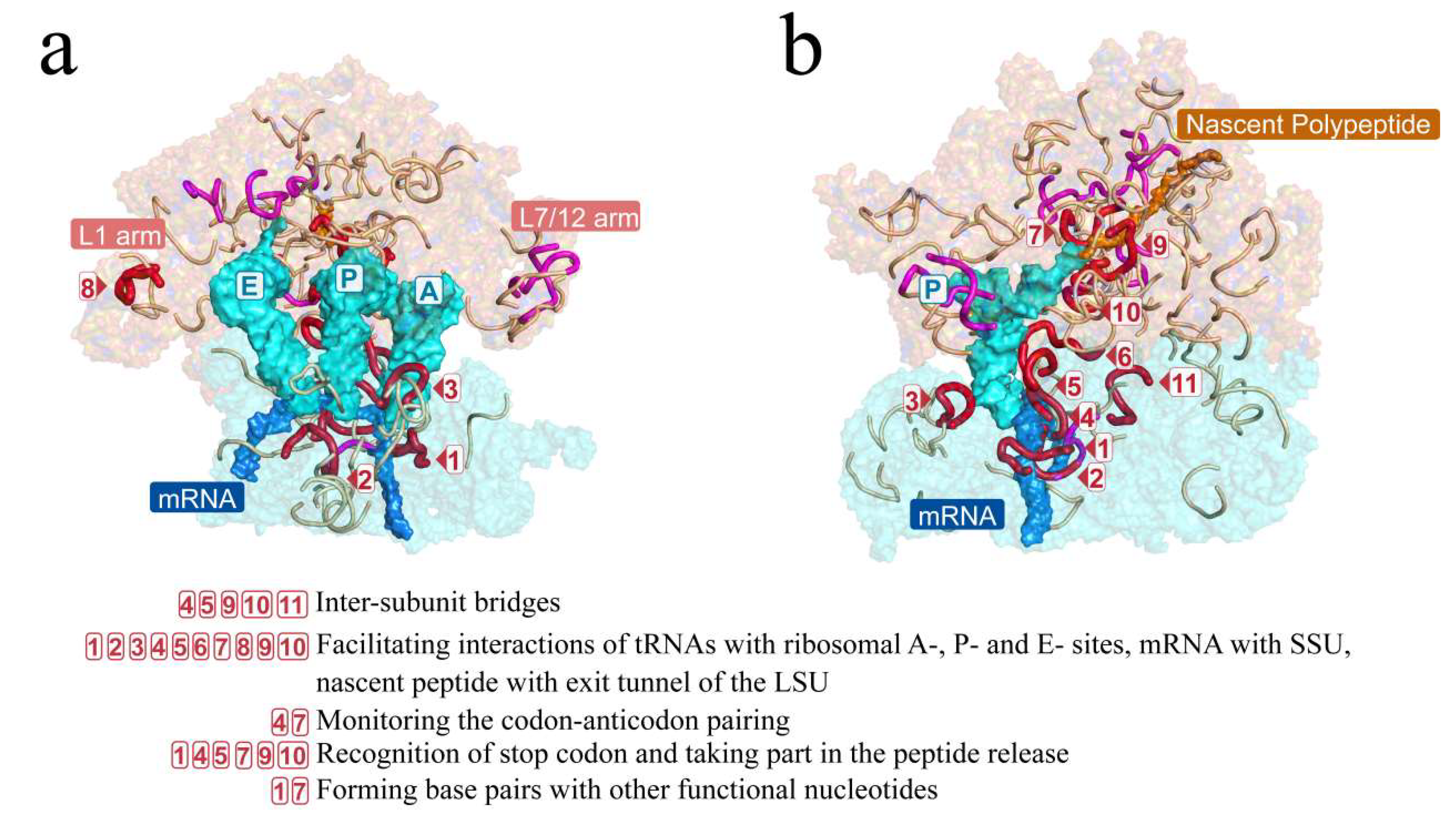
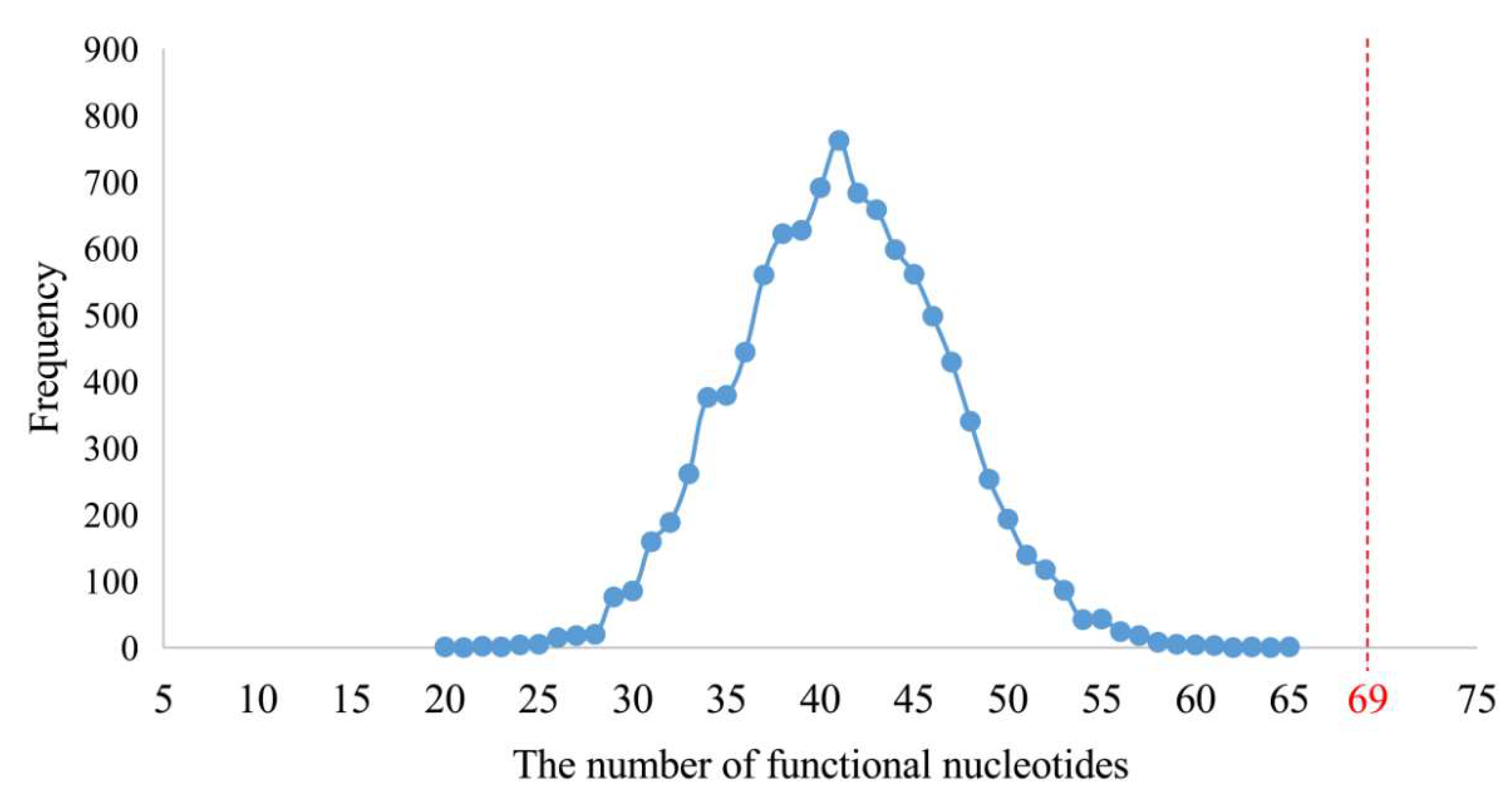
| RY | AUGC | |
|---|---|---|
| Length range of short fragment | 2–15 | 2–12 |
| Representative length in the most concise manner | 11 | 6 |
| Total number of short fragments with the representative length | 75 | 136 |
| Percentage of the overlapped or adjacent short fragments | 68% | 56% |
| Number of short fragments that belonged to the 16S rRNA | 21 | 34 |
| Number of short fragments that belonged to the 5S rRNA | 2 | 2 |
| Number of short fragments that belonged to the 23S rRNA | 52 | 100 |
| Number of short fragments conserved across archaea and bacteria | 36 | 47 |
| Number of universal short fragments (conserved across 5 or 6 kingdoms) | 18 | 29 |
| Percentage of the overlapped or adjacent universal short fragments | 67% | 66% |
| Number of functional sites located in the total short fragments | 69 | 48 |
| Number of universal short fragments that contained functional sites | 11 | 12 |
| Number of universal short fragments that contained no functional sites | 7 | 17 |
| Function | N-Box | N-F75 | References |
|---|---|---|---|
| Interaction with tRNA in A-, P-, and E-sites | 1, 2, 3, 4, 5, 6, 8, 9, 10 | 529 (1-491), 530 (1-491), 531 (1-491), 532 (1-491), 2583 (2-2772), 2602 (2-2788), 1492 (1-1478), 1493 (1-1478), 1494 (1-1478), 1916 (2-2101), 1918 (2-2101), 1926 (2-2114), 2585 (2-2772), 926 (1-891), 956 (1-924), 2584 (2-2772), 2602 (2-2788), 2169 (2-2359), 1913 (2-2101), 2609 (2-2796), 2506 (2-2692), 2555 (2-2750), 2501 (2-2692), 2603 (2-2796), 2505 (2-2692), 693 (1-654), 2116 (2-2304) | [25,26,27,28,29,30,31,32,33] |
| Interaction with mRNA | 1 | 532 (1-491), 693 (1-654), 1156 (1-1132), 1533 (1-1516), 1532 (1-1516), 1530 (1-1516), 1534 (1-1516), 1535 (1-1516), 1536 (1-1516), 1537 (1-1516), 1538 (1-1516), 1539 (1-1516), 1540 (1-1516) | [27,34,35,36,37] |
| Interaction with mRNA–tRNA minihelix | 1, 4 | 1492 (1-1478), 1493 (1-1478), 530 (1-491) | [38] |
| Interaction with nascent peptide | 7, 9 | 2062 (2-2249), 2585 (2-2772), 2506 (2-2692), 2609 (2-2796), 1614 (2-1797) | [39,40] |
| Monitoring the codon–anticodon pairing and maintaining translational fidelity | 4 | 1492 (1-1478), 1493 (1-1478) | [41,42,43,44,45,46] |
| Co-translational monitoring of nascent peptide chains inside the exit tunnel | 7 | 2062 (2-2249) | [43] |
| Recognition of stop codon | 1, 4, 5 | 1913 (2-2101), 530 (1-491), 1493 (1-1478) | [47] |
| Nascent peptide tunnel | 7 | 2058 (2-2249), 2059 (2-2249), 2060 (2-2249), 2061 (2-2249), 2062 (2-2249), 2063 (2-2249) | [30,48] |
| Taking part in the peptide release | 9, 10 | 2585 (2-2772), 2602 (2-2788) | [30,49] |
| Inter-subunit bridges | 4, 5, 9,10, 11 | 900(1-870), 901(1-870), 1493(1-1478), 1495(1-1478), 1496(1-1478), 1702(2-1884), 1703(2-1884), 1704(2-1884), 1705(2-1884), 1912(2-2101), 1913(2-2101), 1923(2-2114), 1928(2-2114), 1929(2-2114), 1932(2-2114), 1933(2-2114), 1960(2-2148), 1961(2-2148), 1962(2-2148), 2506(2-2692), 2585(2-2772), 2602(2-2788) | [50,51] |
| Forming base pairs with other functional nucleotides | 1, 7 | 2061 (2-2249), 2063 (2-2249), 530 (1-491), 2499 (2-2692) | [25,30,52] |
| Interacting with GTPase factors (EF-G, EF-Tu, IF2, RF3) | 2653 (2-2845), 2654 (2-2845), 2655 (2-2845), 2656 (2-2845), 2657 (2-2845), 2658 (2-2845) | [53,54,55,56,57,58] |
| Fragment Set with the Same Length | Fragment Set in the Same Level | |||
|---|---|---|---|---|
| RY Level | AUGC Level | Short | Long | |
| Positive results | More | Less | More | Less |
| Pseudo-positive results | More | Less | More | Less |
| Overlaps | More | Less | More | Less |
| Functional sets | More | Less | More | Less |
Publisher’s Note: MDPI stays neutral with regard to jurisdictional claims in published maps and institutional affiliations. |
© 2022 by the authors. Licensee MDPI, Basel, Switzerland. This article is an open access article distributed under the terms and conditions of the Creative Commons Attribution (CC BY) license (https://creativecommons.org/licenses/by/4.0/).
Share and Cite
Men, Y.; Lu, G.; Wang, Y.; Lin, J.; Xie, Q. Reconstruction of the rRNA Sequences of LUCA, with Bioinformatic Implication of the Local Similarities Shared by Them. Biology 2022, 11, 837. https://doi.org/10.3390/biology11060837
Men Y, Lu G, Wang Y, Lin J, Xie Q. Reconstruction of the rRNA Sequences of LUCA, with Bioinformatic Implication of the Local Similarities Shared by Them. Biology. 2022; 11(6):837. https://doi.org/10.3390/biology11060837
Chicago/Turabian StyleMen, Yu, Guoliang Lu, Yanhui Wang, Jinzhong Lin, and Qiang Xie. 2022. "Reconstruction of the rRNA Sequences of LUCA, with Bioinformatic Implication of the Local Similarities Shared by Them" Biology 11, no. 6: 837. https://doi.org/10.3390/biology11060837
APA StyleMen, Y., Lu, G., Wang, Y., Lin, J., & Xie, Q. (2022). Reconstruction of the rRNA Sequences of LUCA, with Bioinformatic Implication of the Local Similarities Shared by Them. Biology, 11(6), 837. https://doi.org/10.3390/biology11060837




